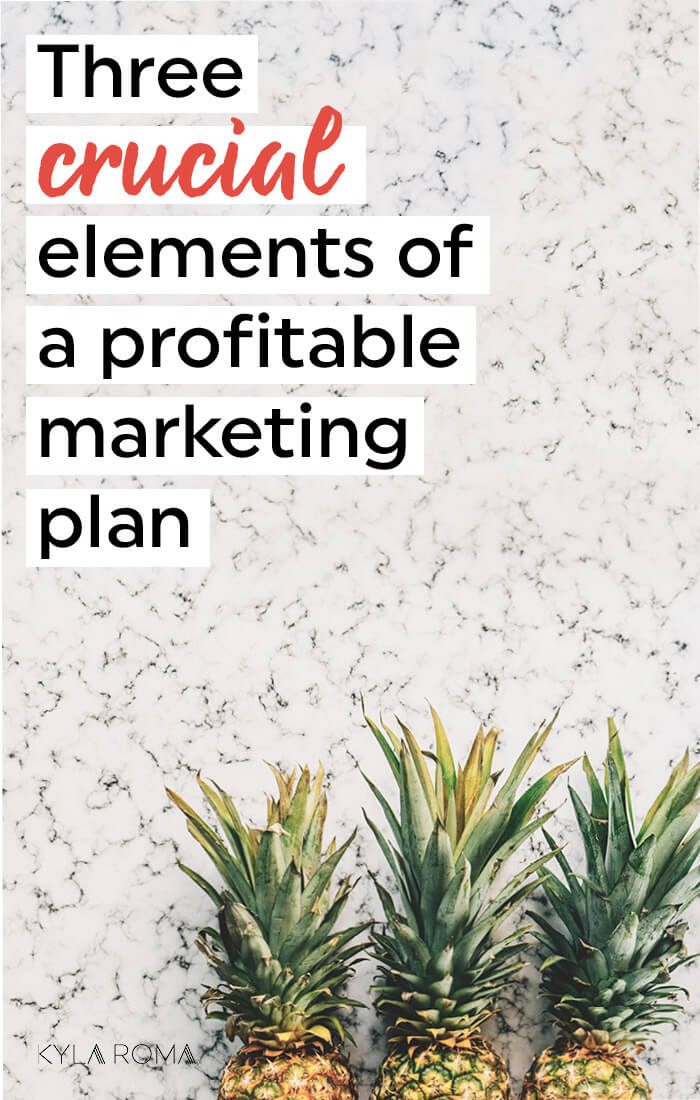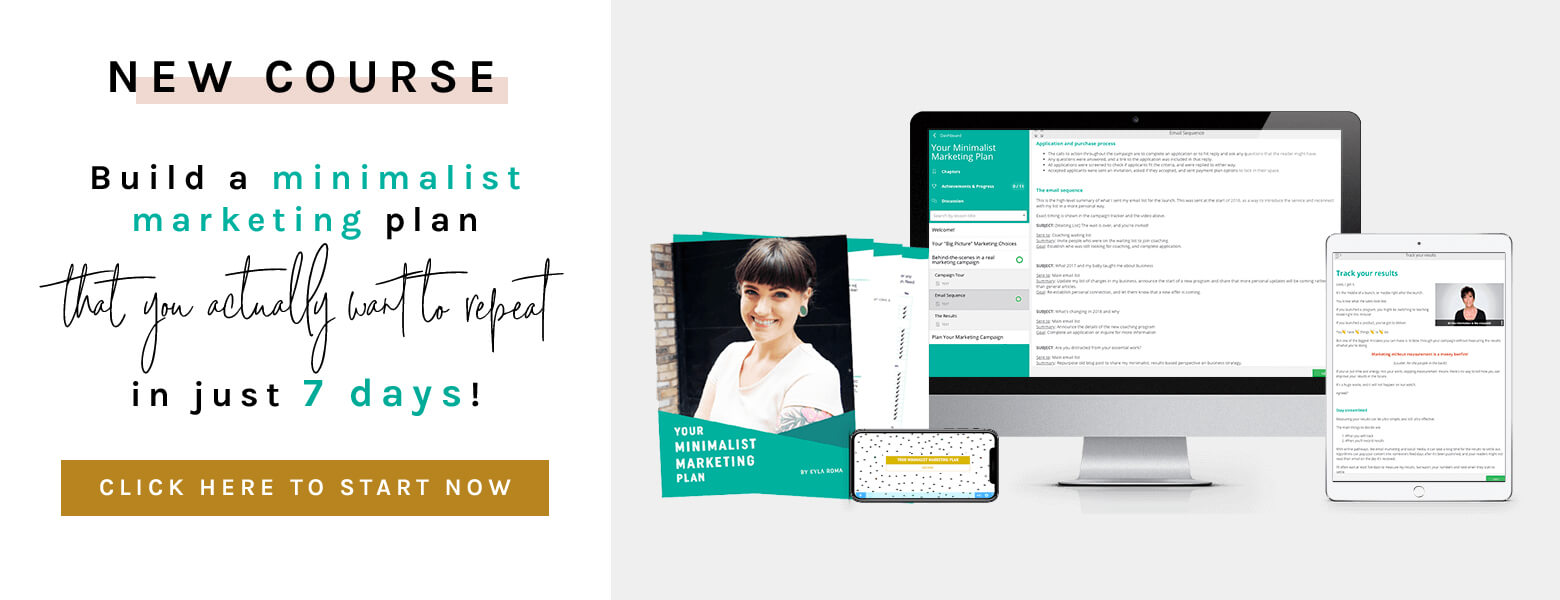Don’t other people’s marketing campaigns always look like one part magic, one part miracle?
We know that behind the scenes, for a business to be a success there's a lot of hard work, but from the outside, it's really hard to tell what that actually is. Aside from Facebook ads, that is. (Am I right?)
I've had the privilege of going behind the scenes in all different kinds of businesses over the last 8-years. I've had clients launch a new service and make $2000 – and be thrilled! I've seen clients launch a new product and earn $80k – and be really frustrated!
But something I get asked a lot when I talk with my boss friends and readers is what do the “big guys” do differently to get such great engagement and strong sales?
How do they seem to create one profitable marketing plan and launch after another?
And most importantly: HOW CAN I GET ME SOME OF THAT? :)
I promise, there’s no hocus pocus involved, and while results might feel divine, they are really the result of measured actions that you can accomplish too.And yes, this all applies to service-based businesses just as much as to product creators. The key is acting on this information – taking it and doing something with it, instead of just thinking about it.
Are you game?
Then read on!

There are three crucial pieces your profitable marketing plan should include:
I suggest you start by putting together a plan for the story you’ll tell, define the traffic paths you’ll focus on to reach your audience, and gather the resources you’ll need during your campaign.
1. Story: Start a compelling conversation
From your perspective, a campaign is about the product or service you’re promoting. That’s why you spend time identifying the features of your product and the various aspects of your service that set you apart from your competition.
But this is where new marketers often get stuck and sound like infomercials: for your audience, the product or service is not the focus. For them, your campaign is actually about engaging with your story, getting involved in the conversation, and becoming invested in the dialogue you create with your content.
Your audience wants a compelling story that teaches them something first. Your product or service should be a natural, helpful next step that comes second.
If you’ve focused primarily on your product in the past, you’re not alone. Many beginning marketers do just that, but over time they learn to create conversations that lead to better conversions. They learn and develop their marketing muscles to create one profitable marketing plan after another.
So, this is your opportunity to do things differently – and in a more effective and value driven way. Write a story based email funnel, instead of a promotion based email funnel.
To plan your story based sales funnel, ask yourself these questions:
- What is the primary client need I want to highlight?
- How does it feel (from the client’s perspective) to have this need?
- What words does my client use to describe this situation?
- How can I frame the question or issue?
- How can I challenge assumptions and deepen the conversation?
- How does my offering solve this problem or add value here?
Use your answers to identify themes that matter to your audience and tie them back to the solutions you provide. Then use those themes to genuinely helpful content that illustrates your point, and you'll start people talking about you and engaging with your brand.
2. Traffic Paths: Build bridges into your business
Now that you’ve planned a compelling story – one that will capture attention and create conversation around your brand – build a bridge to connect you with your audience.
Start by planning how you will connect with the people who already know about your work. You don’t have to do anything new here, you can simply focus on the paths that have worked well for you in the past.
These can include:
- Blog posts and your newsletter
- Email marketing to a segment or more of your list
- Social media engagement include organic reach and paid posts
- Special events such as training, webinars, etc. for your existing tribe
(Not sure which traffic path is most effective for you? I wrote a blog post recently about the 5 most important metrics to watch, and one of them is traffic paths. You can read it here.)
Of course, not everyone knows about your amazing work yet, even though they need exactly what you offer. So, let’s include a few traffic paths to help you reach new audiences with your brilliance.
A few options to consider are:
- Joint ventures to reach a compatible audience
- Affiliate marketing relationships
- Guest posts and podcast interviews
- Webinars or live events to attract newbies to your story
- Content such as a video series, free download, or workbook
Clearly, you can’t use every one of these traffic paths in your campaign. You’re building a few bridges here, not creating traffic gridlock. The goal is not to do more, it’s to identify what works for you and make your efforts as effective as possible, so don’t feel pressure to do it all, okay?
Wondering how to select the “correct” traffic paths for your audience? I recommend following your instincts and diving into a little experimentation. Step out and add something new to your next campaign, even if you are satisfied with what you’ve done so far. You never know what you might discover with a little trial and error.
 3. Resources: Proper preparation for positive results
3. Resources: Proper preparation for positive results
A profitable marketing plan requires more resources than you think at first, which is why many people scramble to pull things together and get what they need. Preparing properly will ensure you are ready to respond as quickly as your audience engages with your story crosses the bridges you build to your brand.
- Fully Trained Team – The time to build marketing skills in your team is NOW – before your campaign begins. Try to anticipate each person’s role and work with them to create a detailed plan for their actions during the campaign. Consider both your administrative needs and the creative roles you need to fill and plan for any needed training time in advance of your campaign.
- Support – Time to look at your contact list and think about the people who can support you during your campaign. Friends with a similar audience may be willing to promote the content you publish during your campaign. They may also be interested in a joint venture or allowing you to be a guest on their blog or podcast. Start the conversation with them now, and make sure you both feel comfortable working together when the campaign begins.
- Collateral – Will you run ads? Share your content on social media? You need graphics. Will you run a webinar? Time to check out some software. Freebies for contests or list building or traffic sources? Put that stuff together now before you really, desperately need it. (And before your freelancer's schedule is booked!)
Put your preparation time in, and watch it bloom into a profitable marketing plan.
Sure, planning and preparation that go into building a profitable marketing plan is a lot of work. If you’re putting together a campaign for the first time, you might be uncertain and feel overwhelmed, too. It’s tempting to skip the planning steps and just see what happens. But trust me, you don’t want to do that.
Something happens when you have a plan – even if the plan isn’t perfect. Most importantly, you give yourself a chance to improve your results over time. And while you're learning, you feel more confident, more relaxed, and more engaged with your audience. And that, my friends, is pure magic.
Feeling overwhelmed and unsure of how to promote your products and services? Marketing is a learned skill – and we get better at it over time. Check out this walk through of planning for marketing success, one step at a time.
LAST UPDATED ON: November 14th, 2017
CATEGORY: All Business & Blogging Posts Attract your ideal customer Content Marketing Strategy

